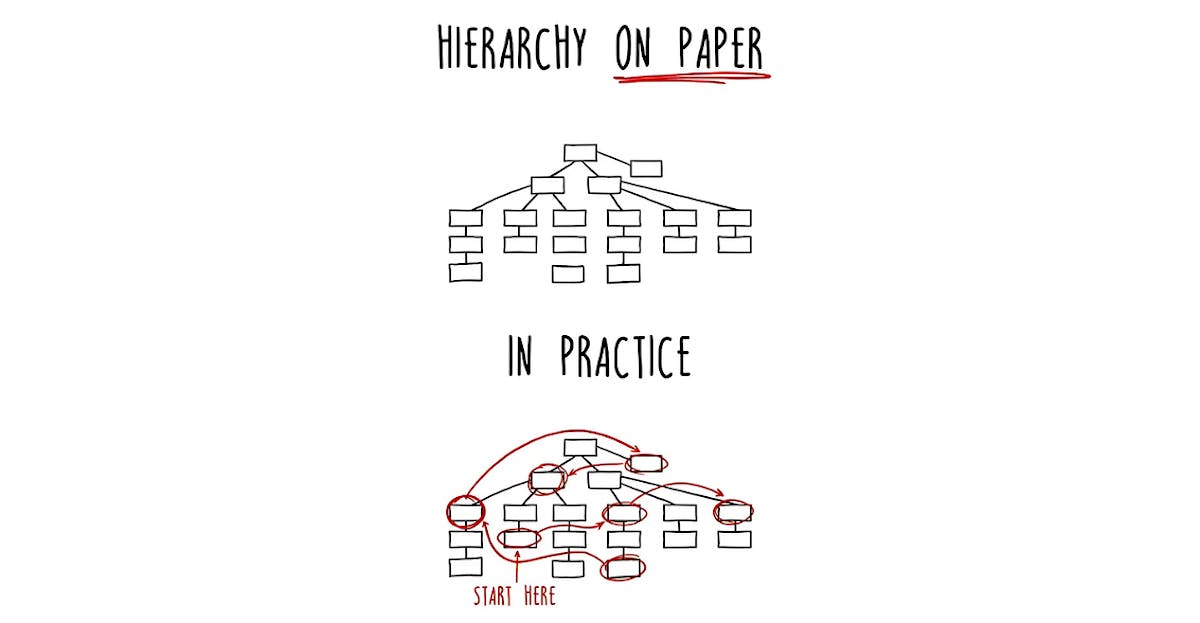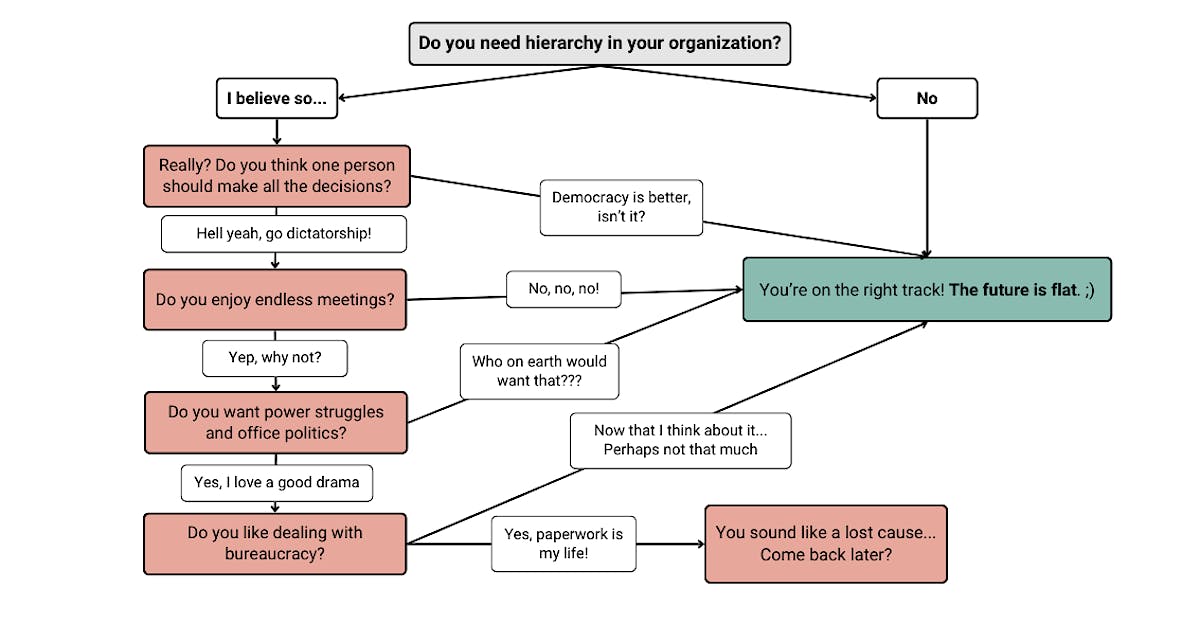Forget org charts. Organizational design is more than arranging boxes and titles. It's how your company actually functions. It's the engine behind how work gets done (or doesn’t). And when it's broken, everything suffers.
We've visited 150+ progressive workplaces. Know what they all have in common? They don't treat organizational design like a static chart. They treat it like a living, breathing system. One that evolves and serves the people inside it.
In this guide, we unpack what organizational design really is, why it matters, and how to rebuild it for today's way of working:
- Why organizational design is broken
- What is organizational design?
- What is the goal of organizational design?
- Why is organizational design important?
- Key principles of modern org design
- Popular org design structures (and how they work)
- How to start redesigning your organization
- Design for humans, not hierarchies
Organizational design is broken (But you already knew that)
Most org charts look tidy, logical, and balanced. Roles in boxes, lines connecting the dots.
There's only one problem. They rarely reflect how work actually happens.
Most organizational design is broken because it's stuck in theory. It’s treated as a one-time exercise led by consultants. The result? A rigid hierarchical structure that might look great in a boardroom but falls apart in real life.
What follows is all too familiar:
- Decisions get stuck in endless approval layers.
- Ownership is unclear (or even worse, non-existent).
- Teams work in silos and duplicate effort.
- People disengage because they don’t know how they fit in.

Bad org design isn't just inefficient. It’s expensive, demoralizing, and slow. And it just doesn't make sense in the modern world.
How to fix it? Not by adding more reporting lines and boxes. You fix it by redesigning how your company actually operates. You make it faster, flatter, and more human.
Ready? Let's change the way we design organizations.
What is organizational design?
Organizational design is more than just an org chart. It's how you intentionally shape your company's structure, roles, and ways of working to deliver your purpose.
It's not just where people sit or who reports to whom. It's how decisions are made, how work flows, and how teams align around what matters most. Done well, org design creates clarity, speed, ownership, and energy. Done poorly, it leads to confusion, gridlock, and disengagement.
It's almost like a blueprint for how an organization operates and evolves.
In its design, an organization can already be flexible, adaptable, and ready to meet the challenges of the business landscape. As you can imagine, the way the organization is designed has a big impact on the company culture and the way people work there.
Most companies still treat organizational design like a one-time project. That's the old-school approach:
- Static org charts
- Top-down authority
- Layers of management
- Siloed teams
- Control and compliance
But in today's fast-moving world, that model breaks down fast. Teams need agility, not rigidity. That's why progressive companies are shifting to a new approach to org design. These are dynamic systems that evolve alongside the business. These structures prioritize:
- Autonomy over hierarchy
- Teams over departments
- Transparency over secrecy
- Trust over control
- Purpose over processes

This isn't theory. It's what we've seen in action across 150+ pioneering organizations. From Haier's microenterprises to Buurtzorg's self-managing teams, organizational design training isn't just for consultants anymore. It's a must-have skill for anyone serious about building a better way of working.
What is the goal of organizational design?
We'll get straight to the point: the goal of organizational design isn't to draw cleaner org charts.
So, what is the goal of organizational design?
It's to make your company work better. With fewer bottlenecks, more ownership, and way less chaos.
With organizational design, you can build a system that allows people to do their best work. That means designing an organization where structure fuels clarity, roles drive purpose, and decisions don't need endless layers of approval.
Here's what great org design actually delivers:
1. Faster decision-making: In a well-designed organization, the right people make the right decisions quickly.
2. Greater autonomy: With the right org design, people know what they're responsible for, and they're trusted to deliver.
3. Aligned roles and purpose: Strong organizational design aligns roles to outcomes and purpose, not just titles and tasks.
4. Better collaboration across teams: Modern org design breaks down silos and creates intentional pathways for collaboration.
Basically, the goal of organizational design is to create the conditions for clarity, trust, and speed. If your org isn't delivering that, it's time to redesign.
Want to learn how to actually do that? Check out our Masterclass: Progressive Organizational Design.
Why is organizational design important?
Structure shapes behavior. When your organization is designed with intention, everything gets better:
5 key principles of modern org design
If you're still designing your organization based on titles, departments, and hierarchy, you're falling behind. Modern org design focuses not on locking people into a structure but on creating a system that evolves with the work.
These are the four principles that drive high-performing, human-centered organizations:
1. Design for adaptability, not permanence.
Stop trying to future-proof your org chart. The only constant is change, so design for it. Build flexible systems that evolve as your environment, team, and strategy shift.
2. Autonomy over hierarchy.
Structure should support people, not control them. Push decision-making down to the people closest to the work. The more autonomy teams have, the faster they move and the more engaged they become.
3. Decisions belong at the edges.
In traditional orgs, decisions travel up the chain and back down again. In modern organizations, decision-making is distributed, not concentrated. That means frontline teams solve problems without waiting for permission.
4. Transparency over control.
If people don't have information, they can't make good decisions. Replace secrecy and silos with radical transparency—about strategy, goals, feedback, and even finances. Trust your people with the full picture, and they'll act like owners.
5. Structure follows purpose (not the other way around).
Don't start with boxes. Start with why you exist. Structure should emerge from your mission. Ask: What outcomes are we here to create? Then design backward from there.

These principles aren't theoretical. They're what we've seen inside the most progressive workplaces around the world.
Want to learn how to apply these principles inside your company? Our Masterclass: Progressive Organizational Design walks you through it step by step.
Popular org design structures (and how they work)
There are many ways to envisage organizational design. Here are the most common org design models and how progressive companies make them work:
How to start redesigning your organization
So, your org design isn't working, and you're ready to do something about it. Great.
Let's build a system that evolves with your people, your product, and your purpose.
Remember, organizational design isn't a one-off project. It's an ongoing work on improving the system, getting rid of things that don't serve you, and shifting your mindset.
The best orgs don't wait for structure to break. They evolve it continuously as they grow. That's how you stay agile, aligned, and human.
Want to redesign your organization the smart way? Our Masterclass: Progressive Organizational Design gives you the tools, knowledge, frameworks, and real-world playbooks to make it happen.
Design for humans, not hierarchies
It's easy to fall back on the familiar. Titles. Departments. Chains of command. But if there's one thing we've learned from studying 150+ progressive organizations, it's this:
Great companies don't optimize for control. They design for clarity, purpose, and people.
They build systems that evolve. Structures that support autonomy. Cultures that trust teams to own their work.
Because in the end, organizational design isn't just about how work gets done. It's about how people experience work. And if your structure is making things slower, harder, or less human, it's time to rethink it.
So ask yourself:
- Where are decisions getting stuck?
- What are people unclear about?
- Where are they disengaged?
- Where is your structure holding you back instead of moving you forward?
These aren't surface-level fixes. But they are possible. And they're well worth it.
If you’re ready to move beyond theory and actually redesign how your organization works, our Masterclass: Progressive Organizational Design can help. It's built for teams who are done with old models and ready to build something better, step by step.